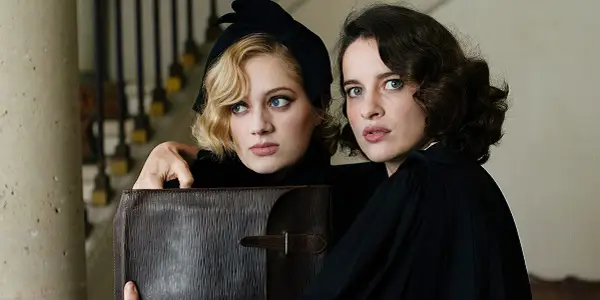
If you, like me, often find yourself nostalgic for the manic screwball comedies of yesteryear—especially those that also happen to contain a healthy dose of murder and mystery—then you’ll enjoy François Ozon’s latest, The Crime is Mine (Mon Crime in French). A loose adaptation of the 1934 play Mon crime by Georges Berr and Louis Verneuil, which has previously been made into two Hollywood movies—True Confession in 1937 and Cross My Heart in 1946—the film centers on two female friends who get tangled up in a murder case and all of the notoriety that ensues. A period piece set in the 1930s Paris rendered so delightfully decadent in classics such as Ernst Lubitsch’s Trouble in Paradise and Mitchell Leisen’s Midnight, The Crime is Mine boasts lush Art Deco production design, gorgeously lit cinematography, and an ensemble cast packed with both up-and-coming and established French talent—including the legendary Isabelle Huppert, chewing the scenery to bits as a faded silent film star who still craves the spotlight. (To be fair, she deserves it!) And while the story may take place in the past, with all of the visual trappings that entails, it’s impossible to not see parallels to today’s scandal and social media-obsessed world, in which there is increasingly no such thing as a bad reason for becoming famous.
So This is Paris
Madeleine (Nadia Tereszkiewicz, winner of the César Award for Most Promising Actress for Forever Young) is a struggling actress who can’t get a role. Pauline (Rebecca Marder, who was nominated for the César Award for Most Promising Actress for Radiant Girl but lost to Tereszkiewicz) is an unemployed lawyer who can’t get a case. Together, they live in a tiny Parisian flat where they are months behind on the rent. Madeleine thought things were about to turn around when she was invited to meet with the great theatrical producer Montferrand about a part; instead, she ends up fleeing in tears after he tries to force himself on her. Meanwhile, her boyfriend, André (Édouard Sulpice), the layabout heir to a failing tire empire, wants to marry a rich girl to save the family business and keep Madeleine around as his mistress.
source: Music Box Films
Feeling like losers in love and life, Madeleine and Pauline seem to be running out of opportunities…that is until Montferrand is found dead shortly after meeting with Madeleine. When the evidence starts to make Madeleine look guilty of the crime, Pauline decides—as her best friend and her lawyer—that the best thing to do is lean into it. In a theatrical trial that makes headlines across France, Pauline argues that Madeleine did indeed shoot Montferrand, but she was merely doing so in self-defense, to protect her virtue. And as Pauline points out in court, why is it that women are treated like children when it comes to their rights, but like adults when it comes to their crimes? (The film makes a point of noting that women did not yet have the right to vote in France in 1935.)
Needless to say, a beautiful blonde in distress paired with a fiery feminist lawyer is a combination cut out for fame and fortune. However, when the real killer surfaces to demand their share of the post-trial spoils, Madeleine and Pauline must figure out a way to preserve their newfound life of luxury…without, you know, actually committing murder.
Girls About Town
Fast-paced and funny, The Crime is Mine is carried by its two sparkling young stars, who are incredibly likable even when doing questionable things like committing perjury for the sake of celebrity. Pauline prepares Madeleine for the trial as though it were a play in which she has the starring role, even drafting a script for her to deliver on the stand and helping her decide what dress would make the most appropriate “costume.” From the way they talk about the case, one would almost assume they don’t realize the severity of the consequences should they fail in their endeavor; seemingly blinded by the spotlight, their optimism verges on delusion as they giddily scan the headlines from the trial, debating the pieces written about them as one would discuss drama criticism. But if you fail on the stage, the worst you can get is a bad review, or an early closing date – not the death penalty. The contrast between the severity of their situation and the almost frivolous way in which they talk about it is a large part of what makes The Crime is Mine so morbidly amusing.
source: Music Box Films
Tereszkiewicz and Marder are very different types but still totally believable as best friends, with Madeleine’s melodramatic airs pairing perfectly with Pauline’s resolute nature. The two friends are foils right down to their appearances; Madeline is a fresh-faced, feminine blonde while Pauline is a brunette whose wardrobe leans towards the masculine—think sweater vests and trousers instead of adorable dresses. (Head costume designer Pacaline Chavanne and team did a wonderful job making me covet both girls’ closets, which are full of practical fits and not flashy monstrosities covered with beaded fringe like most of the 1930s-inspired clothes you find today.) But it’s not just Pauline’s androgynous wardrobe providing the queer subtext that runs throughout The Crime is Mine; the loaded gazes that Pauline directs at Madeleine and the awkward silences that fill certain moments between them make it obvious that Pauline is in love with her best friend but knows that those feelings are doomed to remain unrequited, adding a bittersweet flavor to some of their scenes together.
Later on in the film, Pauline practically falls in love at first sight with Odette Chaumette (Huppert), the glamorous former star who confronts the girls about the truth behind Montferrand’s murder; when Huppert strokes Pauline’s cheek and calls her kitten, well, it’s enough to make you want a sequel showing where that relationship might end up going. To be fair, I’d also love to see a prequel detailing Odette’s epic rise and fall in the French film industry because Huppert is such a madcap delight in the role. She’s absolutely over the top from the frizzy wreath of red hair that surrounds her face to the emphatic way she bites into a sausage over lunch with the girls to the theatrical hand gestures that accompany every line of dialogue. (Fittingly her costumes are also less on the practical side; they are more dated and lean into heavy drama—including jewel-toned gowns and eccentric headgear—leading one to assume she nicked them from the last set she worked on.) Other standouts in the ensemble cast include Dany Boon as an architect-about-town and would-be benefactor to Madeleine and Fabrice Luchini as a put-upon judge who doesn’t understand why people come into his office trying to claim they’ve committed crimes that, as far as he is concerned, have already been solved.
source: Music Box Films
All of this insanity takes place in a beautifully crafted world that pays homage to the 1930s while also adding some modern flavor that suits the storyline’s feminist themes. The Crime is Mine references classic cinema—Madeleine is styled similar to Louise Brooks in Pandora’s Box for a play, while the two girls go to see Danielle Darrieux in Mauvaise Graine early on in the film—without veering too far into pastiche; it stands on its own as an entertaining story without relying on too many obvious Easter eggs to amuse the audience. Scenes that are designed to be flashbacks or fantasies are shot on overexposed 16mm film with no audible dialogue, as though they are throwbacks to the silent era. The rest of the film is shot with warm, luxurious lighting courtesy of director of photography and frequent Ozon collaborator Manu Dacosse, who maximizes the beauty of the film’s primarily pastel-hued palette.
Conclusion
While The Crime is Mine doesn’t reach the lofty heights of the classic comedies that influenced it, it’s all too easy to enjoy such a screwball vision of the past.
The Crime is Mine opens in New York, Los Angeles, and Chicago on December 25, 2023, before expanding nationwide.
Does content like this matter to you?
Become a Member and support film journalism. Unlock access to all of Film Inquiry`s great articles. Join a community of like-minded readers who are passionate about cinema – get access to our private members Network, give back to independent filmmakers, and more.





